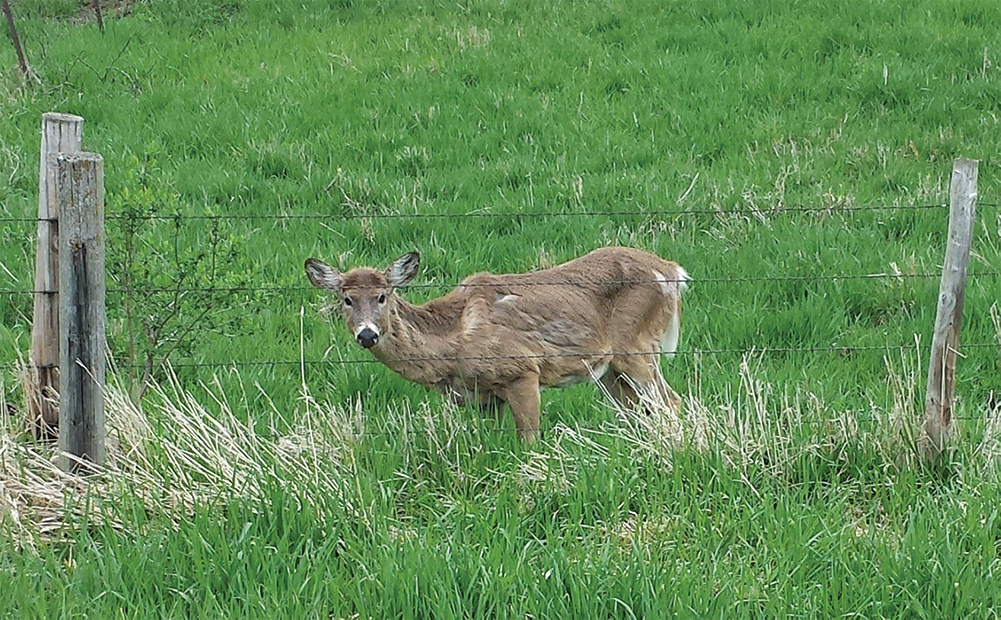By John Felsher
Chronic Wasting Disease, or CWD, affects the nervous system in members of the cervid or deer family, which includes whitetails, mule deer, elk, moose, caribou and other species.
“The disease is caused by mutated forms of normal proteins called prions,” says Chris Cook, the Deer Program coordinator for the Alabama Wildlife and Freshwater Fisheries Division. “Prions are normally found throughout the body and don’t cause problems. When they mutate, though, they become infectious and cause normal prions to mutate. The infectious abnormal prions start accumulating in the brain, nervous system tissues and some lymph tissues. Concentrations of these prions in the brain create microscopic holes in the brain tissue, which lead to neurological problems and, ultimately, death.”

CWD was first identified in captive mule deer in Colorado in 1967 and discovered in wild deer and elk in the 1980s. Since then, CWD has been identified in wild or captive cervids in 26 states, three Canadian provinces and other countries. Fortunately, that number does not include Alabama, at least not yet, but CWD has hit close to the Cotton State recently.
“We’ve been sampling deer since 2002 and haven’t found any deer in Alabama that tested positive for CWD,” Cook says. “The closest confirmation we’ve seen to Alabama has been from Pontotoc County, Miss., and Hardeman County, Tenn. Both of those animals were found in 2018.”
Infected animals may not show any signs of the very slowly progressing disease for a long time. The disease attacks the central nervous system, so deer don’t act like they should. As CWD progresses, signs of being infected become more obvious.
“Once a deer is exposed to CWD, it could take months or even years for it to show any symptoms and die from the disease,” Cook says. “Many deer that have tested positive for CWD looked normal, but as the disease progresses, infected deer become less wary of people and just don’t act right because its central nervous system is not functioning properly. Deer will have difficulty standing and walking, may drool excessively, often drink and urinate constantly and become emaciated.”
CWD has not been shown to pass from deer to humans or other animals outside the cervid family. However, some animals may serve as disease reservoirs and spread the prions across the landscape. For instance, if some types of scavengers eat sick deer, those animals aren’t likely to contract CWD, but they may shed those prions through their feces. Other deer could ingest those prions and become sick.
“There currently is no evidence of deer giving CWD to humans who consume venison or by any other way at this time,” Cook says. “Also at this time, there is nothing to indicate that CWD will cross over into a different species outside of the deer family. A sick deer can transmit the disease to other deer by exchanging saliva or other bodily fluids. The disease doesn’t break down very easily. As the prions accumulate in the environment, they can persist in the soil for years. Potentially, they could be taken up by plants growing in that soil and pass into deer. Once CWD gets established in a population, it stays there accumulating in the environment.”
Many sportsmen like to visit other states or countries to hunt whitetails or deer species not found in Alabama. To keep Alabama free from CWD as long as possible, the state imposes strict laws on the importation of live deer and certain high-risk deer parts from other states and countries. Essentially, hunters cannot bring back anything containing brain or spinal cord materials, large bones or antlers in velvet. They can, however, bring deboned meat, clean hides, clean skull caps and antlers, and finished taxidermy works when they return to Alabama.
For more on CWD and how to handle deer before bringing them back into the state, see outdooralabama.com/deer-hunting-alabama/chronic-wasting-disease-what-you-should-know.
“When possible, field dress and process the deer on the property where it was killed and leave all the waste parts where they originated,” Cook says. “Any people who see deer that aren’t acting right should contact their local Wildlife and Freshwater Fisheries Division office. We want to get a sample for CWD testing from any sick deer. If we do find CWD in the state, that’s not the end of deer hunting in Alabama. We’ll just have to change some things on how we hunt and manage deer in the state to keep the disease as contained as possible.”
To report a deer showing symptoms of possible CWD, see outdooralabama.com/wildlife-section. People can also call Cook at 205-339-5716 or email chris.cook@dcnr.alabama.gov.





